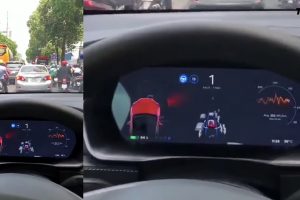- 📷 Tesla’s Sentry Mode captures events around a vehicle using external cameras.
- 🚓 Oakland Police Department uses Sentry Mode footage to solve crimes.
- 🏨 First known use was from a hotel parking lot capturing a homicide.
- 🕵️♂️ Police sometimes obtain warrants to tow Teslas to secure surveillance footage.
- 👮♀️ Sentry Mode helps in arresting suspects, providing high-definition video evidence.
- 🚘 Teslas with Sentry Mode act as mobile surveillance devices, monitoring areas continuously.
In recent years, the collaboration between innovative technology and law enforcement has gained significant traction. One such groundbreaking development is Tesla’s Sentry Mode, which is now an invaluable tool for the Oakland Police Department (PD). Let’s explore how this advanced feature not only assists in tackling rising crime rates but also revolutionizes surveillance and criminal investigations.
The Emergence of Tesla’s Sentry Mode in Law Enforcement
Tesla’s Sentry Mode Defined
Tesla’s Sentry Mode is a sophisticated surveillance system integrated into the vehicle’s design. Its primary function is to continuously monitor the surroundings using external cameras, capturing high-definition footage of events near the vehicle. Initially aimed at protecting car owners from theft and vandalism, it has now emerged as a pivotal tool for law enforcement agencies.
Oakland PD’s Strategic Adoption
In response to increasing crime rates, Oakland PD has strategically adopted Tesla’s Sentry Mode. By utilizing the captured footage, the police have successfully solved numerous crimes, transforming these vehicles into a network of mobile surveillance units. This approach highlights the growing trend of employing advanced technology in public safety measures.
The Impact of High-Tech Surveillance
High-Definition Footage in Crime Resolution
One of the standout features of Sentry Mode is its ability to record high-definition footage that can be instrumental in solving criminal cases. The clear and detailed visuals aid law enforcement in analyzing incidents more accurately and efficiently. This aspect has been especially useful in cases of vandalism and other crimes captured by the Teslas parked in public or private spaces.
Civil Contributions in Crime Solving
Remarkably, civilian recordings from Tesla vehicles have played a crucial role in solving crimes. These recordings often provide unassailable evidence, leading to breakthroughs in ongoing investigations. Such community involvement, albeit indirect, underscores a collaborative effort in enhancing public safety.
Legal and Ethical Considerations
Navigating the Legal Landscape
The integration of civilian-owned surveillance footage into police investigations raises significant legal and ethical questions. To address these, law enforcement agencies have resorted to obtaining legal warrants to seize vehicles and ensure evidence preservation. This legal framework ensures that the use of such footage respects individual privacy rights while advancing public interests.
Ethical Implications
While the advantages are obvious, the use of Tesla’s Sentry Mode in policing also prompts discussions about surveillance ethics and personal privacy. Balancing the benefits of solving crimes with the right to privacy remains a challenge for authorities, necessitating ongoing dialogue and policy adjustments.
Effectiveness in Crime Prevention
Case Studies in Successful Prosecution
Sentry Mode has proven itself as an effective tool in crime prevention and resolution. For instance, it was instrumental in apprehending murder suspects by providing definitive evidence that led to swift judicial action. Such cases exemplify the potential of this technology to serve as a silent but powerful witness in criminal acts.
Conclusion: A New Era of Surveillance
Tesla’s Sentry Mode represents a significant shift in how technology can be leveraged for public safety. By providing a potent combination of advanced surveillance capabilities, it aids law enforcement in tackling crime proactively. However, the success of this integration depends on continually assessing the balance between technological benefits and ethical constraints. As this partnership between technology and policing evolves, it promises to enhance community safety in unprecedented ways.





